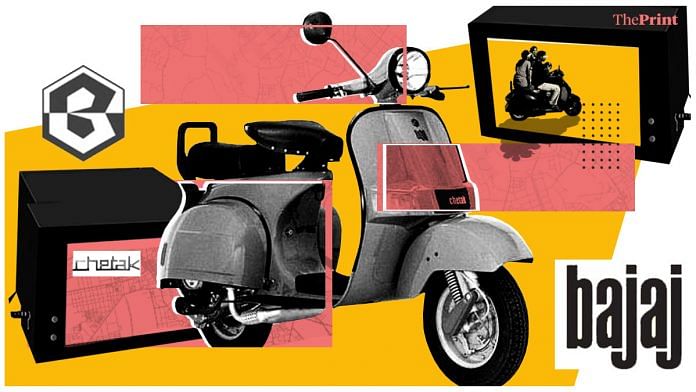Echoes of the famous 1989 “Hamara Bajaj” jingle resurfaced this year when billionaire Rahul Bajaj in late November asked a group of ministers, including Home Minister Amit Shah, a few pointed questions about mob lynching, Pragya Thakur and the government’s stifling of criticism.
The commercial tag line was invoked almost instantly by the troll brigade, but many others, like former actor and Congress member Urmila Matondkar, used it to praise Bajaj.
ThePrint looks back at the 1989 jingle that’s still relevant today.
The family car — on two wheels
As part of the Bajaj Group started by Jamnalal Bajaj in Rajasthan, Bajaj Auto Limited was an automobile manufacturing company that was known for making scooters, autorickshaws and motorcycles. During the 1980s and 1990s, especially, a Bajaj Chetak was a common sight on most Indian roads.
Whether it was about taking short trips to the local vegetable mandi or a young couple out for a romantic spin, the scooter saw it all — including entire families of mother, father and a child or two.
“Bajaj scooter had to be something that would carry everybody around and in those days, the scooter was not really meant for just two people. The scooter that physically can carry only two people strictly speaking, was suddenly carrying the entire family. It was literally meant for the hum do humare do kind of a family. I think that positioning of the brand helped it make inroads into the great Indian family,” Bengaluru-based brand analyst Harish Bijoor told ThePrint.
Yet, the scooter meant more than just a mode of transport to middle-class Indians. For some it was the fruit of arduous labour and a matter of pride, as in Mumbai-based student Shristy Vaidyeshwaran’s family. “For a working-class family like mine, a vehicle of their own meant a big deal. They all have a special corner for it,” she said.
Also read: ‘Man’s best friend’ — cult Czech classic bike Jawa is back because the brand never died
A reminder of Indianness
“If the scooter ever ran out of fuel, all you had to do was put it on a stand, tilt it and then restart it. It would restart, almost instantly, and that was the best part about the scooter,” reminisces Sandeep Poddar, who heads the finance department at Vodafone, from his days in Jamshedpur.
This might seem like a humorous anecdote, but it also speaks to that very Indian principle of jugaad. And the Bajaj group was all about reminding you of your and its common identitity as Indians. By 1989, when televisions were becoming more common, Bajaj decided to take over TV screens. With a series of ads, the group served up gentle reminders to audiences to take pride in indigenous Indian products. Soon, with the opening of the markets, the words Hamara Bajaj took on a new, more personal meaning, while Buland Bharat ki buland tasveer stirred a different kind national consciousness among the masses, telling Indians to not look back. India of the future was expected to be bold, uplifted and fierce.
“Hamara Bajaj was one of India’s first inclusive campaigns. It was an all-embracing brand in the sense that ‘Hamara’ Bajaj meant a lot more than ‘Mera’ Bajaj. It was not about saying this is my Bajaj but it was saying this is our Bajaj,” says Bijoor. This worked on two levels — positioning Bajaj as a family brand but also tapping into an open, inclusive, collective Indian identity.
And it showed in the advertising. An ad for Chetak shows people of different faiths and classes putting their faith in the trusty scooter.
Meanwhile, another ad very much a a part of the campaign invoked the virtues of the Indian man. The Chetak was hailed as a symbol of the true Indian man — honest, righteous and charming.
Also read: Bajaj Tempo Matador: The camper van with a cult following




Had to wait 5-6 years for chetak. A crummy vehicle at best and during the license raj bajaj became rich by selling us junk. Good riddance to bad rubbish. Sycopants became industrialists and the aam admi had to get their pleasures from whatever crumbs were thrown at them.
55t
80s & 90s, then chetak had waiting period of 5yrs
It was sung by Vinay Mandke
Hamara Bajaj – Truly.
We the family of four spent most times in the scooter. It reminds me of the childhood memories. My father passed away 10 years ago and we still have the scooter in his memory. Letting go of the scooter will be equivalent to letting go of my father last memory. That song brings all the memories and emotions.